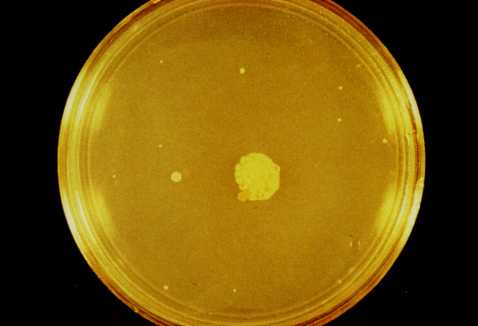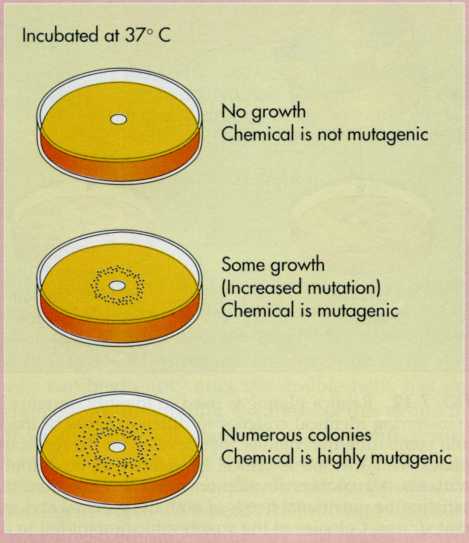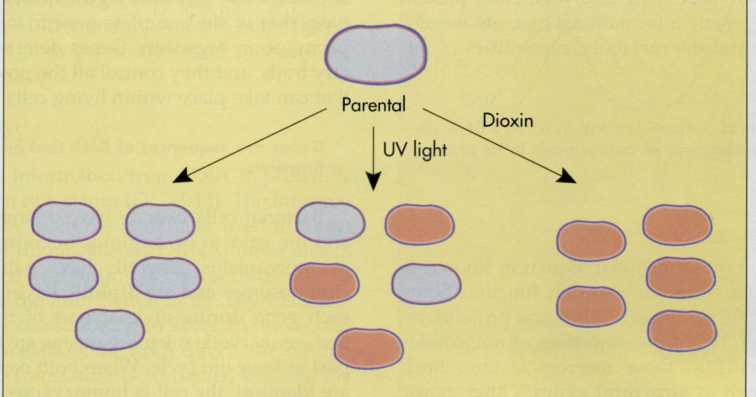
- •In this chapter we will:
- •Structure of dna 195
- •Discovering the Structure of dna
- •Information, is a double helical molecule.
- •Polymerase Chain Reaction (pcr)
- •Replication of dna 201
- •Ames Test
- •One Gene—One Polypeptide
- •Expression of genetic information 207
- •212 Chapter 7 microbial genetics: replication and expression of genetic information
The
fact that microorganisms are susceptible to chemical mutagens
can be used to determine the ability of various chemicals to
increase the rate of mutation, or mutagenicity. In the Ames test
procedure, a strain of the bacterium Salmonella
typhimurium
is the test organism for determining chemical mutagenicity (see
Figure). This bacterial strain is an auxotroph (nutritional
mutant) that requires the amino acid histidine. These organisms are
exposed to increasing amounts of the chemical being tested on a
solid growth medium that lacks histidine. Normally, the bacteria
cannot grow and in the absence of a chemical mutagen no colonies can
develop. If the chemical is a mutagen, lethal mutations will
occur in the areas of high chemical concentration and no growth
will occur in these areas. At lower chemical concentrations along
the concentration gradient, however, fewer mutations will occur
and some of the cells may revert through mutation to nutritional
types that do not require histidine for growth. Such mutants
are able to grow and produce visible bacterial colonies on the
medium. The appearance of bacterial colonies, therefore,
demonstrates that the chemical is a mutagen and the absence of
colonies indicates that it is not.
The
Ames test procedure also is used to screen chemicals to
determine if they are potential cancer-causing agents, or
carcinogens. The theoretical basis for this use of the Ames test is
that nearly all carcinogens that act directly by attacking DNA
are also mutagens. Rather than screening chemicals directly for
carcinogenicity, Bruce
The
Ames test procedure is used to screen for mutagens and potential
carcinogens. The auxotrophic strain used in this procedure,
generally a histidine-requiring mutant of Salmonella
typhimurium,
will not grow on a minimal medium. Mutants that revert to the
prototrophic wild type will grow on this medium. The number of
colonies that develop after exposure to a chemical indicates
the effect of that chemical on mutation rate and therefore its
degree of mutagenicity. The development of many colonies indicates
that the chemical is highly mutagenic.
Ames
and his co-workers thought it would be better to test them first for
mutagenicity. They recognized, though, that some chemicals are
chemically modified in the body and, in particular, some chemicals
are inadvertently transformed into carcinogens in the liver in
an apparent effort by the body to detoxify these chemicals.
Therefore, in testing for potential carcinogenicity, once a chemical
has been found to be mutagenic, it is incubated with a
preparation of rat liver enzymes to simulate what normally
occurs in the liver. Various concentrations of this preparation
are then incubated with the Salmonella
auxotroph to determine whether any products that would cause
mutations are formed. The chemicals that do not produce
mutations are assumed to be noncarcinogenic or are carcinogens that
are not detected by this procedure. Those shown to be mutagenic are
subjected to further testing.
Although
the Ames test does not positively establish whether a chemical
causes cancer, determining whether a chemical has mutagenic activity
is useful in screening large numbers of chemicals for potential
mutagens, because it is highly probable that a chemical that is
a mutagen is also a carcinogen. Since this test can be
completed in 24 hours, rapid identification of a mutagen is
possible. Today, the use of this bacterial assay greatly simplifies
the task of screening many potentially dangerous chemicals,
permitting us to recognize potentially carcinogenic compounds. Using
bacteria in the Ames assay also allows scientists to avoid animal
testing in many cases.
204
CHAPTER
7 MICROBIAL GENETICS: REPLICATION AND EXPRESSION OF GENETIC
INFORMATION


Ames Test
MUTATIONS
205
FIG.
7-13 Various chemical and physical agents increase rates of
mutation. UV light and dioxin are mutagens that cause formation of
mutants (pink
cells).
Factors
Affecting Rates of Mutation
Naturally
occurring rates of mutation are relatively low, about one in a
million times the rate of DNA replication. Various physical and
chemical agents, however, can modify the nucleotides within DNA,
increasing the rate of mutation (FIG. 7-13). Agents that increase
the rates of mutation are called mutagens.
Exposure
to high-energy radiation such as X-rays can cause mutations. Such
high-energy ionizing radiation produces breaks in the DNA
molecule. The time and intensity of exposure determines the number
of lethal mutations that occur. Exposure to gamma radiation, such as
that emitted by an isotope of cobalt, “Co, can be used for
sterilizing objects, including plastic Petri plates, because
sufficient exposure results in lethal mutations and the death
of all exposed microorganisms. Gamma radiation from “Co has also
been used to kill microorganisms on the
surfaces
of some foods, thereby delaying the spoilage of the food.
Exposure
to ultraviolet light also can result in thymine
dimer
formation,
that is, the covalent linkage of one thymine to another
thymine. Covalent linkages are formed between two thymines on the
same strand of DNA. A thymine dimer cannot act as a template for DNA
polymerase, and the occurrence of such dimers, therefore, prevents
the proper functioning of DNA polymerase. Exposure to
ultraviolet light can cause lethal mutations and is sometimes used
to kill microorganisms in sterilization procedures. Sometimes
ultraviolet light is placed above a work surface when it is not in
use to maintain sterility of the surface. Also, air is
sometimes passed over ultraviolet lights in hospitals treating
patients with respiratory diseases to kill airborne pathogens.
Radiation
causes lethal mutations and can be used
for
sterilization of some materials.
EXPRESSION
OF GENETIC INFORMATION
The
expression of genetic information involves using information encoded
within DNA to direct the synthesis of proteins. In a cell, DNA
stores and transmits the complete hereditary information called the
genotype
['ʤenəutaɪp].
Proteins mediate functional activity—called the phenotype
['fēnəˌtīp]
— that is, the actual appearance and
activities of the organism. For example, proteins (enzymes)
catalyze all the metabolic activities of cells and produce the
observable characteristics that distinguish one microorganism
from another.
Proteins
mediate ['miːdɪət]
functional
activity (phenotype); DNA mediates the informational capacity
(genotype) of the cell.
The
sequence of nucleotides within the DNA molecule ultimately
codes for the sequence of amino acids in proteins. Because proteins
are the "action" molecules within cells and nucleic acids
dictate the formation of proteins, it is the ordering of nucleotides
within DNA that provides the information for establishing,
controlling, and reproducing cell structure
